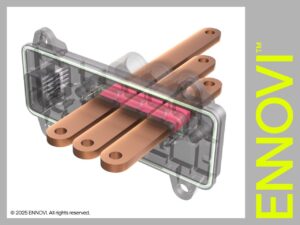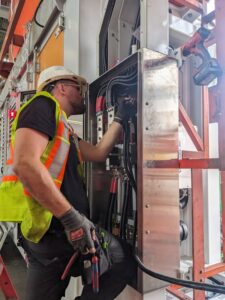It may seem like the electricity in your home is constantly flowing: you turn on a switch or plug something in and you’re ready to go.
In fact, that power fluctuates. If the voltage increases high enough, the power surge could damage your electronic devices or even cause a fire.
This is where surge protectors can help. These devices keep the wires and appliances in your home from burning out during a power surge. Here’s what you need to know about surge protectors, including why you need one, how to keep electronics safe and how to choose one for your home.
What is an energy spike?
Your home’s electrical system typically sends 120 volts of power to wall outlets and light fixtures, but this voltage is not always constant. The power your home receives from the electrical grid ranges between zero and 169 volts. A power surge that can cause damage occurs when the voltage reaches above 169 volts.
Power surges can be caused by factors inside your home, including electrical overload — such as plugging too many devices into an extension cord — and faulty wiring. External causes such as lightning strikes, power outages due to peak demand, or power supply switches at your electric utilities can also cause a surge.
“Energy surges can drain everything that’s important in your home. It can be a very expensive problem,” said Eric Goranson, a Seattle-based designer and home renovation expert who hosts “Around the House,” a nationally syndicated radio show.
Most of the time, you won’t even know a power surge has occurred as long as it’s within the 169 volt range. However, current surges of 170 volts and above can seriously damage electronic devices. This jump in voltage can cause an electrical arc, which can damage sensitive components inside electronics like computers and televisions or even catch fire. Low and frequent power surges can shorten the life of devices over time. Severe surges can damage or destroy power circuits and outlets in your home.
How does a surge protector protect your items?
You can keep your appliances and even your home’s wiring safe with a surge protector. There are two different types: surge protectors, which look like a power strip, and whole-house surge protectors.
Surge protectors work by absorbing and diverting current. Additional power is sent to the outlet’s ground wire—the third prong on modern electrical outlets—and is prevented from reaching any devices plugged into that outlet.
Whole-home surge protectors don’t just protect a few of your devices. Instead, these protectors are connected to your home’s main electrical panel where they monitor the voltage coming into the system.
“When too much power comes in, a whole-house surge protector prevents it from getting to everything else,” Goranson said, noting that a whole-house surge protector can protect your home’s entire electrical system, including large appliances and heating systems. Ventilation and air conditioning. A whole-house surge protector can also prevent electric vehicle charger surges.
Even whole-house surge protectors won’t protect your electronic devices from the millions of volts generated by a direct or nearby lightning strike, but they can handle power surges from lightning strikes that can damage far away. If you’re particularly concerned about damage to your electronic devices, be sure to unplug them before a thunderstorm hits your area even if you have surge protectors.
How to choose a surge protector?
If you’re renting or on a limited budget, surge protectors are the best choice for expensive or essential devices like TVs, computers, gaming systems, phone chargers, routers, modems, and medical equipment. Choose a model that has the number of plugs you’ll need and take factors like spacing into account to accommodate your devices.
Surge protectors are rated in joules, based on how many joules of energy they can absorb from the electrical flow. A rating of 200-400 is the minimum you want to consider, with higher rated surge protectors reaching 2000 joules or more. Additional surge protectors cost about $15 to $25 eachWith multiple sockets that can accommodate multiple devices.
Homeowners may want to consider investing in a whole-home surge protector rather than individual surge protectors. This way, everything in your home that plugs into an outlet is protected — including large appliances and your HVAC system that can’t be plugged into power strip-style surge protectors — as well as the electrical wiring itself. A whole-home surge protector costs between $80 and $300, plus the cost of a licensed electrician to install it for you.
“This is not a DIY project,” Göransson said. “You need to have a licensed electrician handle this problem, because you’re dealing with raw power coming from the pole. That’s something you don’t want to mess with.”
When it comes to choosing a whole-home surge protector, Goransson recommends asking an electrician about recommended brands and purchasing the device from them. They can ensure it’s compatible with your electrical panel and handle the installation. Buying through a dealer comes with another advantage: If there’s a problem with the product while it’s under warranty, the contractor deals with the manufacturer and saves you some hassle.
Frequently asked questions
Are surge protectors and power strips different?
Yes. Power strips and surge protectors may look similar, but only a surge protector can protect the devices plugged into it from a surge.
Do surge protectors need to be replaced?
Most manufacturers of surge protectors recommend replacing the devices every three to five years. Both surge protectors and the entire home should have indicator lights to let you know if they are working properly. Make it part of your home maintenance routine to check the condition of your protective gear regularly.
Do my devices have built-in surge protectors?
Some devices such as laptop and desktop batteries may have some form of built-in surge protection, but it will likely not be sufficient to protect that device from frequent or strong surges. You’ll still want to plug them into a surge protector or use a whole-house surge protector to prevent damage.




